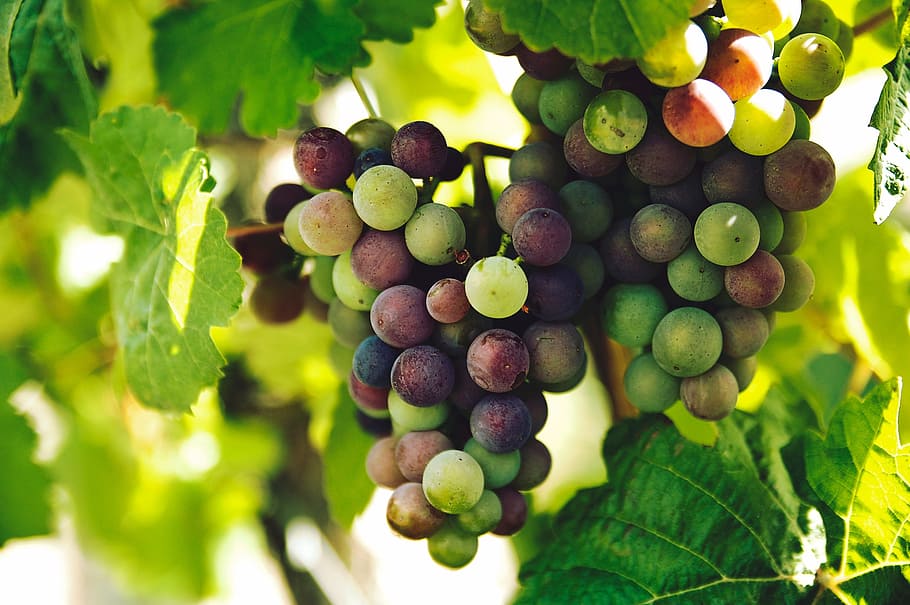| Valiant |
| American; seeded blue fruit; for juice and jelly; very cold hardy; ripens early; cane prune. |
| Van Buren |
| early-ripening, Concord-type grape. Vines are hardy but somewhat susceptible to downy mildew, especially at bloom. Clusters are somewhat smaller and more prone to cracking than clusters of Price, which ripens at about the same time. |
| Vanessa |
| Developed by HRIO, Canada, and is a red dessert grape of excellent quality. The vine is moderately vigorous and among the hardiest of seedless grapes. Grafting may be desirable on many sites to increase vine size (vines grafted on Teleki 5C at trials in Fredonia, New York, however, have shown poor fruit set with very small berries). The seed remnant is usually large and soft; when noticeable it is sometimes a cause for limited marketability. Berries are medium in size on medium, well-filled clusters. Storage potential is good. The flavor is mild and fruity, and berry texture is firm. The fruit quality is among the best of the red seedless types. |
| Ventura |
| Developed in Ontario, Canada in 1974. A cross of Chelois x Elvira, it is a very productive, cold hardy, crack resistant replacement for Elvira. The berries are high in sugar as well as acidity, and ripen with Concord. Although considered a hybrid by its parentage, the wine has a pronounced labrusca aroma and flavor. The vine is susceptible to tomato ringspot virus and may need grafting on virus infected sites. |
| Venus |
| From the University of Arkansas. A vigorous and productive blue-black seedless grape. The medium-large clusters ripen early, producing large berries with mild labrusca flavors. In New York, the seed remnants are hard and noticeable, and fruit rot has been a problem at harvest. Fruit quality is only fair. |
| Venus Blue Seedless |
| Medium to large size grape. It is blue-black colored. Although it is considered seedless, some years there could be a trace of a seed. Its clusters are tightly packed, medium to large sized. It has a sweet fruity flavor with a suggestion of muscat. The Venus grape is excellent for fresh eating, preserves, jellies, wine, and juice. It ripens in August to September. Cold hardy to U.S.D.A. Zone 7. Disease-resistant. |
| Vidal blanc |
| (Vidal 256) A heavily productive white wine grape which produces good quality wine when the fruit reaches maturity. It requires sites with long growing seasons and moderate winter temperatures. Small berries are borne on very large, compact, tapering clusters. Cluster thinning is required to prevent overcropping. Plantings in New York have increased from 35 acres in 1975 to 152 in 1990. |
| Vignoles |
| (Ravat 51) produces an excellent dessert wine, especially when picked late. The fruit can develop very high sugar content while acidity remains high. Vines are very winter hardy with moderate vigor and productivity. Bud break is late, reducing the risk of spring freeze injury. Clusters are small, very compact and very susceptible to Botrytis bunch rot. Acreage doubled between 1975 and 1990. |
| Villard blanc |
| (Seyve-Villard 12-375) A very productive late ripening grape, producing large loose clusters of oval berries. It is best on sites with a longer growing season than Geneva. Wine quality is average. The fruit may be sold as a dessert grape when fully ripe. |
| Villard noir |
| (Seyve-Villard 18-315) A late ripening, productive variety which, on favorable sites, produces good quality red wine. For best performance, choose a site with moderate winter temperatures and a long growing season. Grafted vines are recommended to improve vigor, especially on heavy soils. Cluster thinning is also necessary to prevent overcropping. |
| Vincent |
| Released in 1967 by the Horticultural Research Institute of Ontario (HRIO) at Vineland, Canada. The vine is medium in vigor, very productive and ripens late. This dark blue grape produces a very dark juice that is useful for blending with varieties with low pigment content. Care must be taken to control powdery mildew. |
| Vivant |
| Introduced in 1983 at HRIO, Canada. This white wine variety is vigorous and productive but sensitive to fungal diseases. Interest in this variety in Canada has been decreasing. No cluster thinning is required. |
